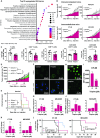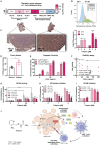The anticancer thiosemicarbazone triapine exerts immune-enhancing activities via immunogenic cell death induction and FAS upregulation
- PMID: 40847419
- PMCID: PMC12372321
- DOI: 10.1186/s40164-025-00700-0
The anticancer thiosemicarbazone triapine exerts immune-enhancing activities via immunogenic cell death induction and FAS upregulation
Abstract
The anticancer thiosemicarbazone Triapine is currently in a phase III clinical trial in combination with radiation therapy and cisplatin. Noteworthy, while radiotherapy induces an immune-activating cell death, so called immunogenic cell death (ICD), cisplatin possesses immunomodulatory and ICD-enhancing functions. Interestingly, although there are several indications that suggest that Triapine could also enhance the immune recognition of cancer cells, no investigations in this direction have been reported so far. Indeed, immune cells (especially cytotoxic T-cells) were found to enhance the anticancer activity of Triapine. This effect might be based on endoplasmic reticulum (ER) stress induction, which on the one hand led to ICD of the cancer cells as indicated by ATP release, calreticulin exposure, high-mobility group box 1 secretion and in vivo vaccination experiments. On the other hand, the Triapine-induced ER stress resulted in FAS upregulation in cell culture as well as in vivo via NFκB signaling. This, in turn, rendered cancer cells more susceptible to FASL (predominantly expressed by lymphoid immune cells)-induced caspase 8-mediated apoptosis. Consequently, our study is the first to unveil the significant role of the (adaptive) immune system in the anticancer activity of Triapine, positioning it as a promising partner for combination with immunotherapy and other immunogenic agents.
Keywords: Adaptive immune system; Anticancer therapy; Cytotoxic t cells; FAS; Immunogenic cell death; Immunomodulation; NFκB; Thiosemicarbazones; Triapine.
© 2025. The Author(s).
Conflict of interest statement
Declarations. Competing interests: The authors declare no competing interests.
Figures


References
Publication types
Grants and funding
- 10.55776/ESP87/Austrian Science Fund
- 10.55776/P31923/Austrian Science Fund
- 10.55776/ESP87/Austrian Science Fund
- P31923-B/Austrian Science Fund
- 10.55776/P31923/Austrian Science Fund
- 10.55776/ESP87/Austrian Science Fund
- 10.55776/P31923/Austrian Science Fund
- 21134/City of Vienna Fund for Innovative Interdisciplinary Cancer Research
- 21134/City of Vienna Fund for Innovative Interdisciplinary Cancer Research
- 21134/City of Vienna Fund for Innovative Interdisciplinary Cancer Research
- WTZ-Ukraine/03-2019 & M/104-2019, M/33-2020; WTZ-Ukraine 08/2023 & M/88-2023, M/30-2024/bilateral Austria-Ukraine grants co-funded by the OEAD and Ministry of Science and Education of Ukraine in 2019-2024
- WTZ-Ukraine/03-2019 & M/104-2019, M/33-2020; WTZ-Ukraine 08/2023 & M/88-2023, M/30-2024/bilateral Austria-Ukraine grants co-funded by the OEAD and Ministry of Science and Education of Ukraine in 2019-2024
- WTZ-Ukraine/03-2019 & M/104-2019, M/33-2020; WTZ-Ukraine 08/2023 & M/88-2023, M/30-2024/bilateral Austria-Ukraine grants co-funded by the OEAD and Ministry of Science and Education of Ukraine in 2019-2024
LinkOut - more resources
Full Text Sources
Research Materials
Miscellaneous

